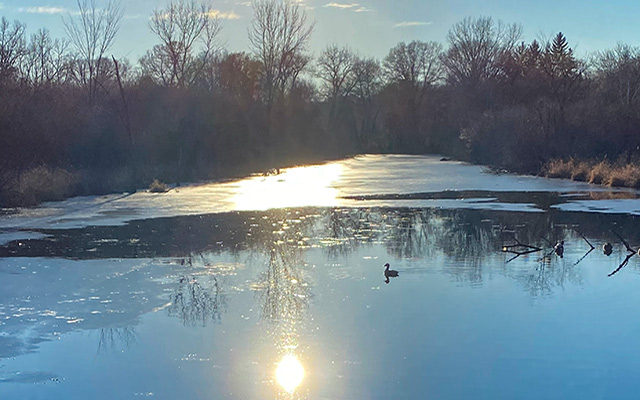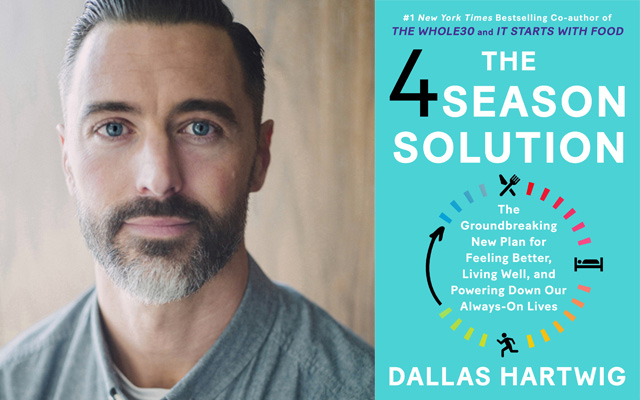By the time Joni Mitchell’s “River” comes on my playlist, I’ve walked a mile into the woods. The light-beams push through the bare trees of the forest and line my path like tiger stripes. On my walks, I notice how the sunlight hits the lake water, then the ice. As the wind picks up, I see the water moving under the sheen of ice covering the lake.
Recently, I’ve paid attention to the light more.
Honoring the changes of season wasn’t something I did much in the past; as a lifelong resident of Minnesota, I tended to prepare for winter in terms of survival of the cold, making sure my car and home were winterized and I had the right mittens and gear to stay protected. After working with the magazine and speaking with our copy chief, Steve Waryan, an avid cross-country skier and frequent participant in the American Birkebeiner race, I realized how fun winter sports could be — and how they can make the season enjoyable. I’ve occasionally rented snowshoes and hit the trails with delight.
After this wild year marked by a pandemic and upended social events, I needed to discover more ways to bring joy to my winter life. I resumed the practice of writing out what I’m grateful for, and I know I’ve been lucky to have my job, my health, my family, and technology to virtually connect with people from afar, including colleagues around the country that I normally wouldn’t interact with.
However, it’s been my walks, nature observations, and education on cultural and spiritual rituals that have brought new meaning to this season. And when the days, weeks, and months have blurred together, this intentional focus has also helped me better define time.
This new season of “therapeutic winter,” as author Dallas Hartwig calls it in his book The 4 Season Solution, is all about healing — and, girl, do we need it this year. “As a season of profound recovery, therapeutic winter is grounded in restfulness and sleep,” he writes. “Therapeutic winter similarly opens you to psycho-emotional healing. . . . [It] entails a natural downturn in mood, when feelings of loss and awareness of mortality can arise. Winter is the time when the trees look barren or even lifeless, but it’s also the time when they are storing up resources to rebound into rapid growth and expansion in the spring.”
Indeed, the sense of mortality and loss is palpable around the globe, and grief has affected us deeply this year. Our family usually gets together with extended family during the winter, a time when we see the cousins from California and an aunt and uncle from Florida; we remember traditions we shared with our elders when they were alive and hosting meals. But we have large families, and staying safe and healthy and avoiding contracting or spreading the coronavirus takes priority. It’s sad to know we’ll miss them even if it’s only for this one year. We also lost a friend suddenly late last month and are still hurting. We have family members who are frontline workers who have worked overtime to help patients, and friends in the service industry whose businesses are struggling.
With all that’s happened this year, it also seemed fitting that the winter solstice — when the daylight is shortest and the night the longest in the Northern Hemisphere — also saw the astronomical phenomenon of the Great Conjunction, when Jupiter and Saturn align so closely that they appear to us as one bright star. The natural world is a lovely messenger when you are open to receiving the wisdom: Planets appear to overlap like our various roles and responsibilities have morphed during the pandemic. The spectacle of light in space also gave me a sense of magic, reminding me to celebrate my strength in juggling it all.
In seeking the light this season, I’ve also learned more about Hanukkah and St. Lucia Day and gleaned new concepts from Christianity on the birth and giving associated with Christmas. Some traditions have spookier elements, such as the mythical and menacing Krampus in Germany and Austria; many cultures also use this time of year to usher out the evil spirits. The food, offerings, and rituals tie to a connection with both the human and natural worlds.
“It is a time for rest for a lot of the animals and for the plants,” says Wilfred Buck, an elder from the Opaskwayak Cree Nation, about the winter solstice, in Indian Country Today. “It is time for the people to replenish their spirit. It is time for them to dream.”
So, as much as I want to heed Joni’s dream to have a river to skate away on, leaving behind the hardest parts of 2020, I’ll keep the wisdom. I’ll hold on to those moments of connections, innovations, love and kindness, and grace we found this year. And I know that the dark times will be balanced with the light — as nature intended.




This Post Has 0 Comments